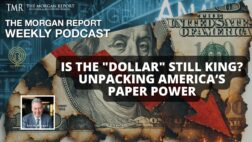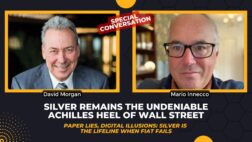Are Gold Stocks Cheaper Than They Were in 2008?
Chris Marchese, Senior Equity Analyst
The Morgan Report
The short and simple answer to this question is yes! Some will say–that is just my opinion. I could show you numerous equations proving the gold stocks were cheaper in 2008 than today and vice versa using similar metrics.
Over the past 4-to-6 weeks there have been countless articles arguing one way or other, however each one I’ve read suffers from one serious flaw, not one has even mentioned how the value of an asset is determined. The value of any asset is the present value of the (free) cash flows generated over the life of an asset.
This doesn’t mean a discounted cash flow model has to be used or even a net asset value calculation which can be accurate if any only if the assumptions or inputs which go into the model are accurate. A valid valuation model must take the time value of money into account. Furthermore, what matters isn’t the current price of the underlying commodity but the near, the intermediate and long term prices.
In this case, the underlying fundamentals for gold and silver are significantly better than they were in 2008. I will discuss why I hold that view but it is far more important to acknowledge why all these articles fail to make a convincing argument.
How the value of an asset is determined goes unacknowledged, in other words, the writers of most (not all) don’t fully comprehend the argument they were making. Even if they had said something like “the price of gold will go to $1,500/oz. in the future”, it would take the time element into account, at least to some degree but this is a rather vague explanation. The reason why Austrian Economics provides a very sound explanation of the modern day business cycle and economics in general is because time is taken into account.
All other “schools” of economic thought such as the Keynesians, Neo-Cons, and Monetarists etc. are flawed for countless reasons including the exclusion of time from human action, in other words they assume economic activity takes places in a vacuum. An example of this is using a ratio calculated by taking a mining stock index, ETF or the like such as the XAU, HUI, GDX. This would be a very useful metric IF we lived in a static world but our circumstance is quite the opposite, being we live in an extremely dynamic world. That being said, using a metric of the XAU/Gold Price or a variant thereof is absurd.
Another article I read attempted to argue that gold miners were making a lot of money as measured by a fairly recent industry wide adoption of reporting costs via “AISC (All in Sustaining Costs)” to replace “Cash Costs”, but this article failed to prove the thesis. The first assumption implicitly states that by taking the average realized gold price less AISC, it results in free cash flow or operating cash flow, the true measure of profitability. If you invest in the mining sector, you know that net income is only a starting point when calculating profitability and that operating performance is seen through operating/free cash flow and true profitability or that which is above and beyond what is needed to reinvest in new and existing operations and can (not necessarily is) paid out as dividends to shareholders is Free Cash Flow.
AISC does provide us with information about the operating performance over a period of time but does NOT say anything about the future. While AISC is a vast improvement over cash costs, it has its shortcomings. The first is that it excludes taxes, which is unavoidable and in reality is a cost arising from operations because the determination a company’s income tax liability is largely a function of how efficient or inefficient operations are as well as the price of gold and accounting or the accounting strategy employed, particularly with deferring income taxes, paying off a previous deferred tax liability etc.
The second is that it doesn’t take into account such things as changes in non-cash working capital. In other words, the average realized gold price less AISC does not measure operating cash flow, let alone free cash flow. Lastly greenfield exploration and other re-occurring non-operating expenses, which are cash outflows and therefore reduce free cash flow are excluded from the fore mention missive.
Why Gold (and Silver) are far more attractive today relative to 2008
All major governments around the world (inclusive of central banks because they are not independent) have pumped remarkable amounts of fiat “money” into the system which despite the relentless arguments of deflation that have been on-going since 2009, has resulted is very substantial monetary inflation.
Let us note that using the classical definition of inflation is an increase in the supply of money and credit with rising consumer and producer goods being a symptom. There was a short period of credit contraction in 2008-2009, but with all the bailouts and currency injected into the system combined with QE1 made this short lived. At the 2014 Silver Summit, during a panel discussion I polled the audience asking everyone to raise their hand if they thought their average cost of living has increased 5% or more annually since 2008. Nearly all those willing to participate raised their hands. The question was at least 5.00%, so if you asked each individual to guess the average annual increase it might actually be higher than 5.00%.
Many precious metals investors think inflation is what will drive gold and silver prices in the future, but 10% inflation doesn’t compare to the ticking debt bomb that will bring down the global fiat money empire. This is not to say that hyperinflation will become a worldwide issue although it may result in some places in the world. Let me state it there will be monetary resets throughout the currency markets. This means, like all other times monetary resets have occurred, a very substantial devaluation of the currency. Reckless monetary policy, while destructive has not compared to the fiscal recklessness, which has caused gross federal debt + state debt + municipal debt + household debt + corporate debt (Non-Financial) + corporate debt (financial institution debt) = (total debt) to become unmanageable.
Today, in Japan total debt/GDP is well over 500%, debt/GDP in the U.S. is over 300% and the same goes for most every country in western world. If you look back throughout history the earmarking of every currency crisis is a debt laden economy. The point is that you can’t compare the price of gold stocks today vs. 2008. Things have changed, the world is dynamic and forecasting the future based on static metrics is simply invalid. It is analogous to comparing an apple on one’s head to the accelerating arrow coming at it from an archer.
Chris Marchese writes for The Morgan Report, consults, and worked as a financial analyst for a major brokerage firm. He is co-author of The Silver Manifesto and participates at all levels in equity analysis including site visits. Learn more about TMR — The Morgan Report here: http://www.silver-investor.com/aboutus.html
David Morgan is a precious metals aficionado armed with degrees in finance and economics as well as engineering, he created the Silver-Investor.com website and originated The Morgan Report, a monthly that covers economic news, overall financial health of the global economy, currency problems, and the key reasons for investing in precious metals.
As publisher of The Morgan Report, he has appeared on CNBC, Fox Business, and BNN in Canada. He has been interviewed by The Wall Street Journal, Futures Magazine, The Gold Report and numerous other publications. If there is only one thing to teach you about this silver bull market it is this… 90% of the move comes in the last 10% of the time! Where will you be when this happens?
Offer does not apply to Premium Memberships.



